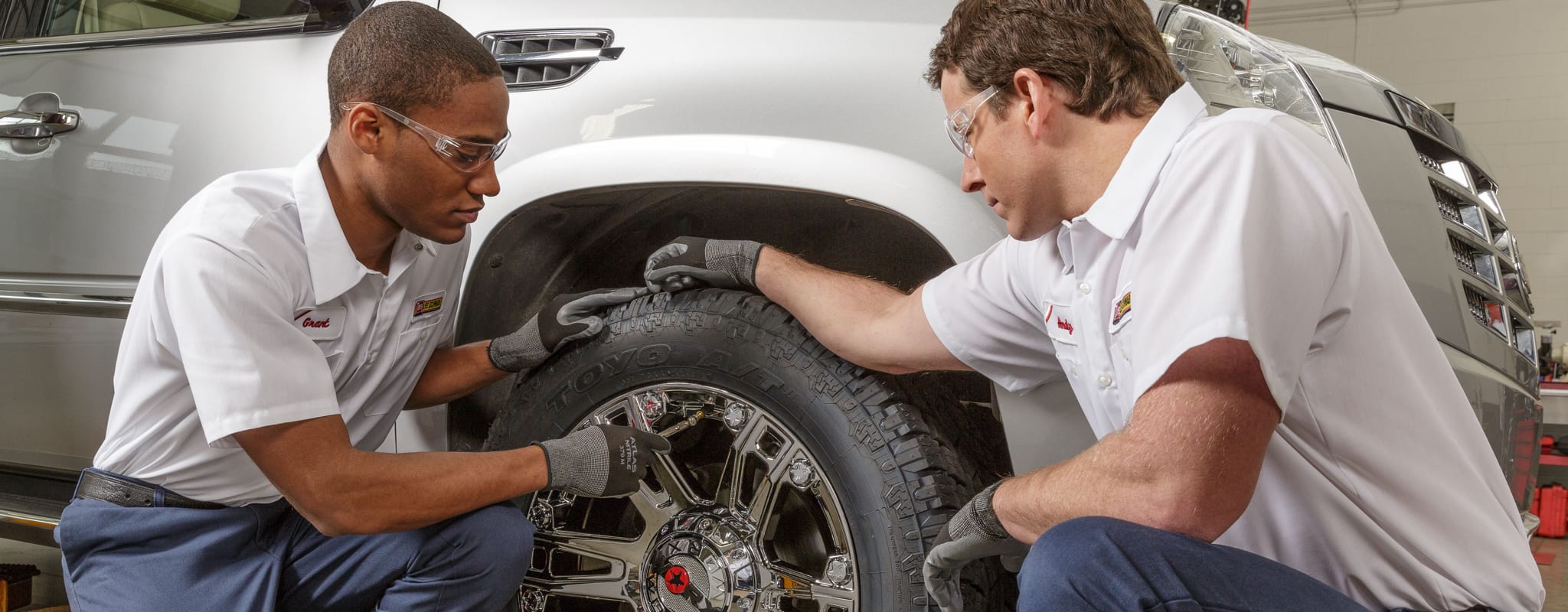Maintain Rolling Smoothly: GMC Tires Service by Morris Tires
Maintain Rolling Smoothly: GMC Tires Service by Morris Tires
Blog Article
Tire Service: The Influence of Climate Conditions
When it comes to ensuring optimal efficiency and safety and security on the roadway, recognizing the effect of weather condition problems on tire solution is crucial. GMC Tire Service. In this conversation, we will certainly explore the elaborate relationship in between weather conditions and tire solution, dropping light on the value of weather-specific tire upkeep practices and considerations.
Heat and Tire Performance
When subjected to heats, tires experience changes in performance that can dramatically impact vehicle safety and handling. The heat generated from extended driving or hot weather condition problems causes the tire rubber to soften, leading to minimized step life and increased wear. As the rubber comes to be softer, the tire's grasp when traveling decreases, impacting stopping distances and general traction. In extreme situations, extreme heat can even create tire blowouts, posturing an extreme security danger to the vehicle and its passengers.

Cold Weather Effects
Winter conditions can have a considerable influence on tire performance and security. As temperatures decrease, tire rubber can set, leading to decreased traction on icy or snow-covered roadways. In winter, tires may additionally lose atmospheric pressure a lot more quickly, which can affect handling and gas efficiency. Additionally, chilly temperatures can create tire sidewalls to tense, enhancing the risk of damages from holes or various other road hazards.
To reduce the effects of chilly climate on tires, it is critical to routinely inspect tire stress and inflate them to the manufacturer's advised degrees. Using winter months or all-season tires designed for winter conditions can likewise enhance grip and hold on icy or snowy roads. Appropriate tire upkeep, consisting of regular evaluations for wear and damages, ends up being much more vital during chillier months to make certain optimum efficiency and safety and security.
Rainy Issues Influence
Tires with from this source worn-out footsteps are a lot more vulnerable to hydroplaning, where a layer of water develops up between the roadway and the tire surface area, leading to loss of traction. To combat this, motorists should frequently check their tires for ample tread deepness and take into consideration investing in tires specifically designed for wet problems.
Additionally, stormy weather can additionally reduce visibility, making it challenging for vehicle drivers to see the road in advance plainly (GMC Tire Service). In such conditions, it is important to adjust driving speeds appropriately and preserve a risk-free complying with range to allow for sudden quits. Correctly filled with air tires can additionally help in preserving control on wet roads by offering far better handling and grasp
Snow and Tire Safety And Security
Snow-covered roads posture one-of-a-kind difficulties for vehicle drivers, highlighting the value of correct tire choice and maintenance. When driving in snowy conditions, having the best tires can make a substantial distinction in safety and security and performance. Wintertime tires are made with unique rubber compounds and tread patterns to offer far better grip on snow and ice contrasted to all-season tires. The much deeper treads and sipes of winter months tires help grip the road better, lowering the threat of gliding and slipping.

It is essential to comply with manufacturer guidelines when installing and utilizing tire chains to avoid damage to the tires and vehicle. By selecting the best tires, keeping correct rising cost of living, and thinking about additional grip aids like tire chains, vehicle drivers can Full Article improve their security when navigating snow-covered roads.
Weather-Related Tire Maintenance
Weather-related tire upkeep encompasses an array of methods intended at guaranteeing optimum tire feature and longevity in different climate scenarios. One key facet of weather-related tire maintenance is tire pressure regulation. Inspecting tire step routinely and changing tires when step wear reaches a certain deepness is essential for maintaining grip and stability in adverse weather.
Conclusion
In verdict, weather conditions have a substantial influence on tire performance and security. From warmth influencing tire pressure and put on to chilly weather condition lowering grip, it is essential to take into consideration the weather condition when preserving and using tires.
In this discussion, we will certainly check out the elaborate connection in between weather problems and tire service, losing light on the relevance of weather-specific tire maintenance methods and considerations.

Report this page